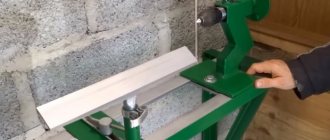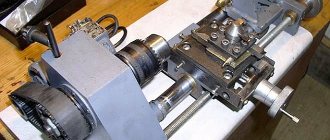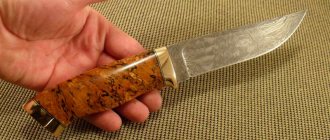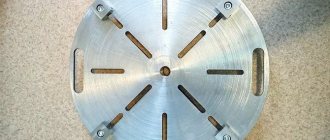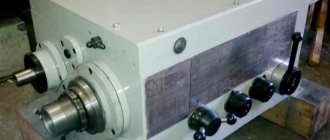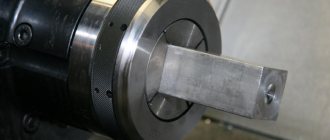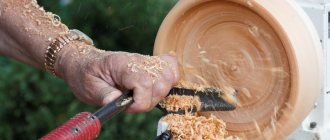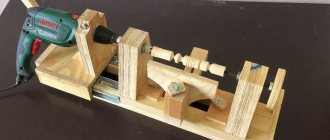In a home workshop, it often turns out that in addition to the existing tool, the smallest thing is missing - a lathe. And it’s not that wood crafts require perfectly cylindrical or spherical parts, it’s just that sometimes you want to do something that has been planned for a long time. So the thought arises, what if you make a wood lathe with your own hands, such a small machine that will take up little space and make it convenient to work with.
The device of a wood lathe
Sooner or later, almost every craftsman begins to get sick of the idea of assembling his own wood turner. Some come to this on their own, after much calculation and thought, while others remember their childhood, and the school workshop there also had woodworking machines. And it’s not difficult to assemble a woodworking machine in the image and likeness of a school one. After all, you can certainly find material in the form of pipe sections in the garage.
The first step is to remember all the main parts of the design of that same school wood lathe. There seem to be few parts here, but each of them plays a specific role, without which everything turns into a pile of scrap metal.
The basis of any machine is the bed. This is a massive base on which all other equipment is mounted. The bed must be as strong and rigid as possible; during operation it must withstand heavy loads not only in the form of a massive workpiece, but also in the form of vibration and the action of multidirectional forces when processing a wooden workpiece.
The headstock of a lathe is a device in which the drive shaft is mounted. On one side of the shaft, a workpiece clamping device is installed - a self-centering lathe chuck, a faceplate or a device onto which a wooden workpiece is screwed or hammered. On the other side of the turning shaft, a drive gear is attached, a pulley with one or more grooves for a belt drive. The turning shaft must provide rotational motion at a speed of up to 3000 revolutions; this is enough for domestic needs. Therefore, the turning shaft is usually mounted on bearings or bushings. The shaft axis is the main axis of the lathe, and the higher the shaft is above the bed, the larger the diameter of the workpiece can be machined. The processing of parts on the machine is carried out using hand cutters, and given the speed of rotation of the shaft, careless touching the pulley or belts can cause injury, so the front assembly must be covered with a protective screen or casing. Rigid fastening of the protection to the headstock is a prerequisite for safe operation.
The tailstock is installed on the opposite side. This is a rigid stop, with a cone-center, which is located exactly along the axis of the turning shaft. The center can move along the axis to secure the workpiece. To fix the position of the center, it is necessary to provide a mechanism for its fixation.
When working on a lathe, hand tools are used. In order not to keep them suspended, a support is installed between the front and rear headstock - a stop for the incisors.
To rotate the working shaft, a drive is installed; it can be an electric motor with direct or belt drive, or it can be driven by muscle power. By the way, the first wood lathes were manually driven - like a bow saw, but later they were replaced by a foot drive.
Review of components for self-assembly of a “folk” wood lathe
You can make a lathe with your own hands quickly and inexpensively. And to reverse engineer Chinese crafts and evaluate their strengths and weaknesses in order to then make them better is absolutely priceless.
If you want to discuss reverse engineering wellcam under cat, discuss it in the comments
There have already been several reviews of simple small-sized wood lathes for $30, but almost every review mentioned the disadvantages of Chinese designs. My review will be useful for those who are ready to assemble such a machine themselves, avoiding in advance the mistakes that the Chinese make, and will also have the opportunity to immediately change the composition of the components to better ones.
I will try to consider the composition and design of this machine, I will give a list of spare parts that make up such a machine. And I'll try to assemble it from scratch.
So here's a great review from mmasco
and no less big from
bdos
.
Photo of the machine in action from the bdos
In general, Chinese crafts resemble clippings from old DIY magazines.
Essentially, they simplified all the machine parts. Instead of a headstock, they have a motor + bracket. Instead of a tailstock, they have a support and something like a center. Instead of a side support (hand rest), they sculpt everything. Well, the bed is a section of a structural profile
Let's look at the design in a little more detail. Next there will be info from nemoi13
As you can see, instead of the headstock there is a powerful DC motor type 775, with a key chuck and a live center. The drive center is the simplest. You can make it yourself from scrap materials
It’s good that it’s not like this, otherwise I’ve seen something like this in other configurations
Next, let's evaluate the profile used. These are variations of the 60th profile extrusion, that is, the distance between the grooves is 30mm.
Additional information about the profile
You can use profile 3060 and 6060, as well as other sizes, for example, 3090 allows you to conveniently place a side stop
Structural profile 3060
You can buy the profile at Soberizavod and Dux
The tailstock of the machine is a plate with a support. The caliper is equipped with flange bearings (Pair F686ZZ) and a center. The center is the simplest. You can also buy or make your own
Now a short overview and links to the components. To begin with, I’ll show you what I bought myself and what came out of it.
Headstock
Engine 775 - for headstock
This is a powerful motor that is used in simple screwdrivers and other power tools.
There is a “simpler” option in terms of speed, the 775 engine for $8. Characteristics:
Rated voltage: DC12V-36V Operating voltage: 12V No-load speed: 13000~15000rpm rated current: 0.32A rated power: 150W size: 98 x 42mm shaft: 5mm
The engine is quite heavy and large in size
The rotor is equipped with two radial bearings of type 625zz
We are primarily interested in the landing dimensions
and shaft diameter (5mm)
Issue price from $8 to $13 on average (indicate various parameters such as engine speed)
There are interesting 550 engine kits including bracket and chuck, priced at $10
And knowing the diameter of the shaft, we can select a chuck for about $6
Please note that almost all cartridges come with adapter bushings for various shaft diameters. My 775 with a 5 mm shaft. If you take a smaller engine, with a 3.17 mm shaft, then look for a cartridge with a corresponding adapter
Next, we will use one of the advertising photos of the lathe. The drive center for the wooden workpiece is clearly visible.
The drive center is a rod with teeth (also known as trident, live center). For example, you can purchase a drive center (“trident”) for $2.37 (plus shipping)
Bracket for mounting the 775 engine $1.55 (but + shipping)
Tailstock.
This is what the caliper and the center of the tailstock look like. The original also contains an adapter plate, since the caliper mount and the profile grooves do not match
The photo shows the “center” itself - that is, a pointed shaft that is mounted on bearings
The caliper is a standard SK13. Costs about $1.7 per piece. Initially, this is a caliper that is designed for installing cylindrical shafts. In the machine, bearings with a diameter of 14 mm are clamped into it.
As a matter of fact, the bearings themselves are with a F686zz flange. The size of the bearings in the original Chinese product is 6x13x5mm. Cost approximately $0.63 pcs, you need two pieces
Next, I offer a large selection of centers for lathes to choose from. Using the keywords “lathe center” and “lathe live center” you can find an acceptable option for the price
Next comes the hand rest (or side support). The Chinese machine uses a simple bracket. But Ali has a more convenient side rest than the original. Cost $6, size about 60mm, just right for profile 3060
Well, little things. I couldn’t find a set of wood cutters for less than $25/8pcs.
Although no, there is a simpler option for $15
Key words: “Wood Cutter Carving Tool” I’ll say right away that the cheaper it is, the worse the steel, the worse it will be to use (they will quickly become dull)
The power supply is like this, with smooth adjustment. I think we can come up with something better and cheaper, using “folk” versions of unframed sources.
The only thing I will say is that it is better to take more powerful power sources (such as LED power supply), but to install a regulator for adjustment (issue price is $3). Keywords “DC motor speed regulator”
If you need a pedal to turn on the machine, you can look here in the review.
You can install this Velcro holder for sanding
I don’t count hardware, buttons, acrylic covers.
Actually everything. There is nothing else in this machine.
Now I'll show you what happened
In order to try out the idea, I used 3D printed parts. It's faster and easier. Selected and installed the cartridge. I turned out the centers from scraps of 8mm shaft. A perforated corner from a store with fasteners as a handy. Then there were attempts and tests
To be honest, the build quality greatly affects vibration and cleanliness of processing.
3D printed components are quite flexible, which caused vibration of the workpiece at high speeds
A few recommendations
: - use high-quality components - some of the Chinese “defects” can be made independently (centers, fastening brackets, body, etc.) - the machine requires a massive bed. The profile can be screwed to the tabletop or secured in another way
But overall the idea is correct. I have provided a list of the main components; with the right approach, you can assemble the same thing, but with better quality.
In general, I recommend using not a direct drive from the engine to the workpiece, but through a belt
Thus, the machine turns out to be more “adult” Link
Additional information - drawings
Drawing of motor 775. Mounting holes 2 pcs, in the center you need to make a cutout for the bearing
Bracket for mounting the 775 motor
Drawing and dimensions of profile grooves 3060 Drawings of SK calipers. In the original SK13, you can choose any other bearings
Additional information on where to buy a profile and more
I machined the drive centers for the lathe from scraps of an 8mm shaft, which, like the machine profile from Duxe. The 8mm profile and guides are best bought in Russian stores, since such pieces of iron are very expensive to deliver, and the Chinese quality of the guides leaves much to be desired . If you have time, now the promotion is minus 500 rubles per review. It’s very convenient, I think I’ll recoup part of the cost. And if you indicate the coupon “MYSALE3” when ordering, you will also receive a 3% discount.
Selecting a transfer method
In most homemade wood lathes, the working drive is provided by the two most popular methods - direct transmission or through belts. Both schemes are excellent for small-sized lathes with primitive devices for clamping a wooden workpiece in the form of a trident and a cone.
Direct transmission
This is a simple and effective way to drive a turning shaft. The actual working shaft here is the rotor shaft of the electric motor. The engine itself is attached to the frame or raised above the support. A clamping device is installed on the axle - a lathe chuck, a faceplate or a regular trident. This is, in principle, the whole scheme of direct drive of a lathe. The advantage of this scheme is that there is no need to look for a special turning shaft, grind out supports for it and center it. In the motor housing, the shaft is already mounted on bearings, and the engine itself has standard mounting units. The disadvantage of this scheme is that it is necessary to protect the windings from dust and shavings that will form during wood processing, and also, if you clamp the workpiece too tightly, there is a risk of the motor jamming and failure.
In addition, direct transmission does not allow adjustment of the speed. If the engine produces 1425 rpm, then the workpiece will also rotate, alas, this is clearly not enough for turning hardwood.
Belting
The design of the headstock using a belt drive significantly expands the capabilities of the lathe. Even if a pulley of the same diameter is used, this makes it possible to increase the shaft rotation speed and protect the electric motor from heavy loads; in this case, it is definitely not in danger of jamming.
If a multi-lane pulley is mounted on the working shaft, and the engine is mounted on a movable slide, then it becomes possible to regulate the speed of rotation of the shaft by moving the belt from a smaller diameter to a larger one. This is the best option; it makes it possible to process wood of a wide variety of species.
Motor selection
The electric motor is selected depending on the power and size of the workpiece being processed. To work with workpieces longer than 50 cm and with a diameter greater than 10, it is recommended to choose a motor with a power of 300-400 watts. For small portable wood saws, a power rating of 80-180 watts is recommended. For mini versions used by modellers, motors with a power of 40-60 watts are also suitable.
Important parameters are also the number of revolutions and the type of voltage for operating the motor. In a home workshop, it is better to have an asynchronous motor operating from a 220-volt household network, but for large lathes for serious tasks, it is better to opt for powerful three-phase motors connected to an industrial network. For direct transmission, high-speed motors are usually used. And for a belt drive it is better to install a motor with a standard 1420 rpm.
Options for mini-lathe models
When purchasing a wood lathe for home use, it is recommended to choose imported models. They are of better quality compared to domestic models.
Imported ones have high power. When choosing, you should pay attention to price, quality, functionality. A good choice is when the ratio of the listed parameters is optimal.
HolzStar DB450
HolzStar DB450 is made in China. Costs approximately 12,000 rubles. This mini-machine is equipped with a cast iron frame with minimal vibration. In this case, small parts will be processed with maximum precision.
The advantages of this model are that the machine has a high spindle rotation speed. The indicator can be adjusted: 500 – 3150 rpm. The machine operates with a power of 370 W. Weight 38 kg.
Proma DSO-1000
The most affordable and high-quality among Czech woodworking machines is the Proma DSO-1000 model. Such a machine costs approximately 6,500 rubles. Has a power of 400 W. You can adjust the spindle speed in the range of 850 – 2500 rpm.
Weighs about 35 kg, has compact dimensions.
JED JWL-1220
The Chinese-made JED JWL-1220 mini woodworking machine is more expensive than the models described above. On average the price is 18,500 rubles. But, such a unit has a power of 750 W.
The frame is made of gray cast iron. Other elements of the device are made from the same material. This material eliminates vibration when working with wooden parts. The engine is equipped with 6 speeds and 2 modes.
In the first mode, rotation speed: 400 – 3300 rpm. In the second mode, you can smoothly switch to speeds from 500 to 3900 rpm.
The machine is secured with a quick-release lever and stands on stable rubber feet. The tool comes with a 710 mm long frame. The weight of the equipment is approximately 45 kg.
Corvette 71
The lathe has a power of 370 W, a maximum spindle speed of 3150 rpm. Can operate at five different speeds that switch smoothly.
The Corvette 71 device is used for sharpening, grinding, and polishing wooden workpieces. Thanks to the belt drive, it is protected from overloads and operates with minimal noise.
For the manufacture of products with large diameters, a faceplate is additionally used.
Materials and components
Metal is usually used to construct machines, but as practice shows, you can assemble a small lathe from improvised means, for example, pieces of plywood, wooden blocks and metal plates.
The simplest and most successful material for work is plywood; it is a strong and lightweight material that can withstand heavy loads. It’s not for nothing that plywood is used to build airplane fuselages, and if it can withstand overloads there, then it can withstand the overload as the main material for a lathe.
Connections can be made using furniture bolts, confirmat, self-tapping screws. Strengthening the structure can be done using furniture steel plates.
Manufacturing principle
It is recommended to make a wood lathe using ready-made components and parts, minimizing the manufacture of parts yourself.
At the initial stage, it is recommended to make a drawing indicating all dimensions. If possible, it is recommended to make a model out of cardboard; it will show all the subtle parts of the project. This is cheaper than correcting errors during assembly from expensive materials.
The second stage is cutting the material. When working with plywood, you will need a jigsaw or circular saw. First, the machine bed is cut out, glued and bolted together. The second stage is the design of the drive and headstock. Next is work on the tailstock and tool rest.
At the final stage, additional devices are manufactured - a copier, a milling device, and a grinding table. As practice shows, you can make a miniature lathe for modeling from plywood 18-24 mm thick in 3-4 days.
Installing the headstock and tailstock
The headstock of a lathe can be made in different design solutions. For its manufacture, you can use either ready-made units with bearings and an axle, or home-made ones.
In the first case, you can fit a hub with an axle from the front wheel of a bicycle under the turning shaft; in the second, you can simply buy two sealed bearings with an internal diameter of 10 mm, a bolt 10 mm thick, and several washers and nuts.
The supports for the headstock assembly are cut out of plywood. Holes for bearings are drilled in them. And then, bearings with a turning shaft are fixed in the holes and secured with clamping bolts. After this, the headstock of the lathe is firmly attached to the bed.
The tailstock assembly is made according to the template of the front headstock supports. A correctly made tailstock of a lathe with your own hands will be when the center of the lathe chuck and the cone center coincide. The easiest way to do this is by holding a regular pencil in the chuck and bringing the tailstock closer to it, marking the center point. After this, you can drill a hole and insert a bolt with a nut and locknut and a center sharpened to a cone.
Podruchnik
A tool rest for a wood lathe is needed as a stop on which the cutter will rest during operation. It is optimal to make the tool rest adjustable in height and so that it can move and be fixed anywhere on the frame between the headstocks. The material can be different - metal or even plywood, the main thing is that its edge on which the cutter will rest is rigid, so it is recommended to reinforce it with a metal plate. It is recommended to make the tool rest of a wood lathe adjustable - this will allow you to expand the number of operations on the machine and process parts not only along, but also across the axis of the machine.
How to choose the right one
To ensure that the choice of a wood lathe is correct, experts advise focusing on the following criteria:
- power;
- dimensions and weight;
- size of processed elements;
- spindle rotation speed;
- thickness of processed parts;
- availability of additional functions.
If you plan to use a lathe for processing small parts, as a hobby, then the priority will be not accuracy and power, but noiselessness. In this case, it is recommended to pay attention to low-power models that emit minimal noise or to models equipped with noise protection. To work at home, it is enough to purchase a lathe with a power of no more than 500 W.
To process workpieces of different sizes in home workshops, you can use machines with a power of 500 - 1000 W. Large machines reduce vibration during operation, so if space in the workshop allows, it is better to choose larger models.
When choosing a wood cutting machine, you should take into account the dimensions of the parts being processed. For a summer residence, it is enough to purchase a household model of the device. If you have to process a lot of material every day, it is recommended to buy a high-quality professional wood cutting machine.
It is also important to choose the correct distance between the centers of the tailstock and headstock or faceplate. These values may vary between models. They influence the accuracy of fasteners.
Often, when working with wood, it is necessary to change the speed of rotation of the workpiece. Therefore, when choosing a wood lathe, pay attention to whether it is equipped with a speed controller. You can adjust it stepwise or smoothly. With smooth adjustment, it does not need to be disconnected from the network; all processes occur smoothly and without sudden jerks.
For processing soft wood, experts recommend choosing machines with a spindle speed of 400 rpm. Hardwood will require a high speed unit. The maximum spindle speed is 3500 rpm.
When purchasing a wood lathe, you should pay attention to whether it has additional advantages, for example:
- Digital display. Makes it easier to work with workpieces, as you can visually control all processes, especially in problem areas.
- Auxiliary copier. Allows you to make many identical parts.
- Reversing eliminates the need to re-feed the workpiece, thereby speeding up the work process.
When choosing a wood lathe, it is important to study it first, and before purchasing, you should carefully compare all the pros and cons of different models and manufacturers.
How to choose a wood lathe - video
Design and principle of operation
A wood lathe is made up of parts that complement and enhance each other. In addition to the main components, it can be equipped with various devices designed to work with wooden parts.
A wood lathe consists of the following main components:
- Bed. To ensure the stability of the machine, all its parts are secured using a heavy frame. These are two vertical ribs attached to a fixed base. You can store tools and accessories in the lower compartments. Transverse rails are attached at the top to move the caliper and tailstock.
- The headstock consists of a chuck, a bearing and a machine control system. Inside there are movable gears, with the help of which the spindle rotates, various threads are cut, etc.
- The tailstock is a moving unit. Thanks to the tailstock, there is additional fixation of the workpiece by pressing it with the tailstock, in other words, it serves to support the workpiece during processing in the centers. It will also help to cut threads or drill a hole in the workpiece; for this, drills or taps are inserted into the quill.
- Stop for the cutter (handle). This is a movable element that can move both parallel and perpendicular to the axis of the machine and be fixed in the right place.
Thanks to the listed main components, the lathe copes with the assigned tasks of wood processing.
The operating principle of wood lathes is based on the method of processing the workpiece with a cutting tool (cutter); only the feeding of the cutting tool can differ: automatically or manually.
Before starting work, the workpiece is mounted in a chuck or on a faceplate, depending on the size and shape of the workpiece. After this, the tool rest is installed in the required position for comfortable work with the cutter.
It is important to check whether the tool rest is touching the workpiece; to do this, simply turn the workpiece secured in the chuck by hand and see whether it catches the tool rest or not.
Basic methods of securing a workpiece
Parts can be fixed on a lathe in two ways:
- between the centers of the headstock and tailstock;
- using a chuck or faceplate.
The first fastening method is considered the most common and reliable. It is used to process bars of large length or diameter without end processing. When rotating the workpiece, you must also ensure that there is no runout.
The second method of securing the workpiece is used in cases where it is necessary to process the ends of the workpiece or those that cannot be clamped into the chuck. The workpiece is secured with bolts, clamps or teeth. The fastening allows you to securely hold parts when performing comprehensive turning of workpieces.
The work is done in two steps. On the first one, rough processing is done at an angle of 15 - 30 degrees. Then they begin finishing at an angle of 45 degrees.
What other types of machines can be made
Even the simplest homemade wood lathes can be turned into multifunctional devices by equipping them with additional equipment. In addition, using ready-made components and parts from other equipment, you can assemble an excellent model for home creativity.
With a copier
This device will make it possible to put into production the production of similar parts. With a copier, the easiest way to turn out a chess set, cutlery handles and other items. The essence of this device is to fix a template with the profile of a future plywood blank or a finished wood part on a tool rest. To work in this case, you will need to upgrade the hand cutter by installing a limiter on it. When processing wood, the cutter processes the part, and having reached the required diameter, it rests against the edge of the template, and then, moving along the relief, it creates the desired profile on the part itself.
Mini
A mini wood lathe is needed primarily to gain initial woodworking skills. The tabletop machine is also useful for creating crafts, such as checkers or chess, and for professional use - for modelers creating architectural models or exhibition dioramas. This model is usually small in size, because most parts are rarely longer than 10 centimeters.
From an electric drill
This type of tool is simply created to be used in the construction of lathes for woodworking. Essentially, this is a ready-made headstock - there is a motor, there is a clamping chuck, there is an electric drill speed control. All that remains is to clamp the body in a clamp and install the tailstock opposite. Of course, it’s not worth working on it for hours, but for small parts this is what you need.
Types of lathes
Modern manufacturers offer a large number of types of woodworking equipment. Their classification determines the scope and technical capabilities of each sample. All types of lathes are divided according to the following indicators:
- application area;
- performance;
- number of operations performed;
- permissible part sizes.
The scope of application is divided into categories:
- industrial machines or machining centers;
- semi-professional equipment;
- household lathes.
Each of them includes several models of such devices. Each of them serves to solve specific practical problems. All lathes are divided into professional, semi-professional and household. Each of them serves to solve a certain class of problems in the manufacture of wooden parts. Any stationary machine requires large areas for installation and access to powerful high-voltage networks. A special class are compact units that can be placed on a desktop or workbench. The tabletop machine is very convenient for processing small parts in small quantities or producing an exclusive part.
Each of the machines of a specific type has its own performance. This depends on the permissible processing speed and the availability of modern mechanization means or the complete replacement of manual control with automatic control. Such units are equipped with numerical program control. They have the highest productivity and a large number of operations performed. Such machines are mainly included in the group of industrial equipment. They are heavy (some of them weigh more than 200 kg). The power of the engines located on such units reaches 1 kW. The number of operations performed depends on the design features that determine the possibilities for attaching the required cutting tool. To perform the planned number of operations, CNC machines are used
Semi-professional lathes are used for processing small batches of wooden blanks. They are much lighter than professional units. Its weight does not exceed 90 kg. The power of the installed motor is 0.5 kW.
The table-top machine is of greatest interest to home craftsmen. Its use is limited by placement capabilities, availability of a power source and the dimensions of future crafts. They are light in weight, not exceeding forty kilograms. They are equipped with low power motors, less than 0.5 kW. Each of these machines is capable of carrying out a wide range of processing procedures. They are divided according to the types of such operations: only milling, copy-milling, thickness planing, screw, pure turning, combined (to perform several types of operations, the machines are equipped with automation devices programmed for the sequence of required operations.
